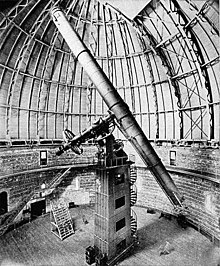Yerkes Observatory: Difference between revisions
No edit summary |
→Popular culture: "about seven minutes." It's not just a passing reference, it's a substantial little chunk of the film. |
||
| (3 intermediate revisions by the same user not shown) | |||
| Line 39: | Line 39: | ||
== Popular culture == |
== Popular culture == |
||
| ⚫ | [[Image:Chainreactionyerkes.jpg|thumb|left|150px|Chase scene across Yerkes Observatory roof in "Chain Reaction"]]Yerkes Observatory is the setting for about seven minutes the 1996 movie ''[[Chain Reaction (film)|Chain Reaction]]'' <ref>[http://www.anl.gov/Media_Center/Chain_Reaction/anchainrvw.html Argonne is star in 'Chain Reaction'</ref> including a gunfight on the roof of Yerkes Observatory and an airboat chase across frozen Geneva Lake. |
||
| ⚫ | Yerkes Observatory is the setting for |
||
== See also == |
== See also == |
||
Revision as of 17:23, 10 September 2008
 Yerkes Observatory, January 2006. | |||||||||||
| Alternative names | 754 YE | ||||||||||
|---|---|---|---|---|---|---|---|---|---|---|---|
| Named after | Charles Yerkes | ||||||||||
| Organization | University of Chicago | ||||||||||
| Observatory code | 754 | ||||||||||
| Location | Williams Bay, Wisconsin, USA | ||||||||||
| Coordinates | 42°34′13″N 88°33′22″W / 42.57028°N 88.55611°W | ||||||||||
| Altitude | 1050 feet (334 m) | ||||||||||
| Weather | See the Clear Sky Clock | ||||||||||
| Website | astro.uchicago.edu/yerkes/ | ||||||||||
| Telescopes | |||||||||||
| |||||||||||
| | |||||||||||


The Yerkes Observatory, itself claimed to be the birthplace of modern astrophysics, [1] is an astronomical observatory of the University of Chicago in Williams Bay, Wisconsin. It was created in 1897 by George Ellery Hale and financed by Charles T. Yerkes. The observatory represented a shift in the thinking of observatories, from mere housing for a telescope and observer, to the modern concept of observation equipment integrated with laboratory space for physics and chemistry. A 102 cm (40 inch) refracting telescope built by the master optician Alvan Clark is located inside. It is the largest refracting telescope used for scientific research (a larger demonstration refractor, the Great Paris Exhibition Telescope of 1900, was exhibited at the Paris Universal Exhibition of 1900).
In addition to the Yerkes refractor, the observatory also has a 102 cm (40 inch, referred to as 41-inch (1,000 mm) to prevent confusion) and a 61 cm (24 inch) reflecting telescope. Several smaller telescopes are used for educational outreach purposes.
Current research includes the interstellar medium, globular cluster formation, infrared astronomy, and near-Earth objects. Additionally, the University of Chicago maintains a sizable engineering center in the observatory, dedicated to making and maintaining scientific instruments. As of May 2007, the engineers are working on the High-resolution Airborne Wideband Camera (HAWC), which will be an integral part of Stratospheric Observatory for Infrared Astronomy (SOFIA).
The current director of the observatory is Dr. Kyle M. Cudworth.
Development and preservation plans
In March 2005, the University of Chicago announced plans to sell the observatory and its land on the shore of Lake Geneva, Wisconsin. Initial reports had two purchasers interested, Mirbeau, an east coast developer who wanted to build luxury homes, and Aurora University, which has a campus straddling the Williams Bay property. The Geneva Lake Conservancy, a regional conservation and land trust organization, has taken the position that it is critical to save, in place, the historic Yerkes Observatory structures and telescopes for education and research, as well as to conserve the rare undeveloped, wooded lakefront and deep forest sections of the 77 acre (31 hectare) site. On June 7 2006, the University announced it would sell the facility to Mirbeau for US$8 million with stipulations to preserve the observatory, the surrounding thirty acres, and the entire shoreline of the site.[2] Under the Mirbeau plan, a 100-room resort with a large spa operation and attendant parking and support facilities is to be located on the 9 acre (4 ha) virgin wooded Yerkes land on the lakeshore -- the last such undeveloped, natural site on Geneva Lake's Geneva's 21-mile (34 km) shoreline. 72 homes are to be developed on the upper Yerkes property, surrounding the historic observatory. These grounds were designed more than 100 years ago by John Olmsted, the brother of famed landscape architect Frederick Law Olmsted, designer of New York's Central Park.
In view of the public controversy surrounding the development proposals, the university suspended these plans in January 2007.[3] The university's department of astronomy and astrophysics then formed a study group, including representatives from the faculty and observatory and a wide range of other involved parties, to plan for the operation of a regional center for science education at the observatory. [4] The study group began its work in February 2007 and its final report was issued November 30, 2007.[5]
Popular culture
Yerkes Observatory is the setting for about seven minutes the 1996 movie Chain Reaction [6] including a gunfight on the roof of Yerkes Observatory and an airboat chase across frozen Geneva Lake.
See also
External links
![]() Media related to Yerkes Observatory at Wikimedia Commons
Media related to Yerkes Observatory at Wikimedia Commons
- Yerkes Observatory (official site).
- Description and history from the National Park Service.
- Save Yerkes
- Yerkes Study Group
Notes and references
- ^ Observatory website
- ^ Agreement provides for preservation of historic Yerkes Observatory
- ^ Topic Galleries - chicagotribune.com
- ^ Yerkes Study Group formed to consider observatory’s future
- ^ http://astro.uchicago.edu/yerkes/ysg/YSG_Final_Report.pdf
- ^ [http://www.anl.gov/Media_Center/Chain_Reaction/anchainrvw.html Argonne is star in 'Chain Reaction'

